|
Friday, June 21
- Breakfast: blueberry-stuffed French toast
- Breakfast: chorizo and egg burrito
- Bratwurst-cooked-in-beer sandwich
- Seafood linguine
- Barbecue chicken
- Barbecue pork spare ribs
- Turkey and cucumber salad wraps
- Strawberry summer salad with chicken
- Texas-style chili
- Vegetarian chili
Wilson Hall Cafe menu
|
|
Friday, June 21
Dinner
Closed
Wednesday, June 26
Lunch
- Stuffed portobello mushroom with spinach and feta
- Romaine, strawberry and orange salad
- Vanilla bean cheesecake
Chez Leon menu
Call x3524 to make your reservation.
|
|
All-hands meeting with Nigel Lockyer - June 28
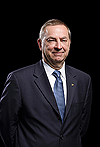 |
|
Nigel Lockyer
|
An all-hands meeting with newly appointed Fermilab director Nigel Lockyer and University of Chicago President Zimmer will take place Friday, June 28, at 9:30 a.m. in Ramsey Auditorium. All employees and users are invited. The meeting will be also be webcast.
On Thursday, Fermi Research Alliance LLC announced the appointment of Nigel Lockyer, director of Canada's TRIUMF laboratory for particle and nuclear physics and a professor of physics and astronomy at the University of British Columbia, as the next director of Fermilab.
Read the press release
|
Entropy is not disorder
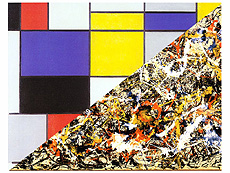 |
Top-left: a low-entropy painting by Piet Mondrian. Bottom-right: a high-entropy painting by Jackson Pollock.
|
Entropy is a fundamental concept, spanning chemistry, physics, mathematics and computer science, but it is widely misunderstood. It is often described as "the degree of disorder" of a system, but it has more to do with counting possibilities than messiness.
Entropy is the number of configurations of a system that are consistent with some constraint. In thermodynamics, the study of heat, this constraint is the total heat energy of the system, and the configurations are arrangements of atoms and molecules. For instance, the molecules of water in an insulated thermos are always moving, colliding, changing positions and speeds, but in a way that keeps their total heat energy fixed. The number of molecular configurations is a very large number— so large that it would be an understatement to call it "astronomical." To make this number manageable, entropy is described by the number of digits in the number of configurations: a million is 6, ten million is 7, a hundred million is 8, and so on.
The association with disorder comes from the fact that we often call systems with many possible configurations "messy" and more constrained systems "clean," but this need not be the case. The picture above compares the artwork of Piet Mondrian with that of Jackson Pollock. We could say that Pollock's painting has more entropy, not because we subjectively think it's messier, but because there are more possible configurations consistent with the artist's intent. Move a single drop of paint a few inches and it's still essentially the same painting. A stray drop on Mondrian's painting would ruin it. In this case, the constraint is the artist's vision and the entropy is the number of possible ways to realize it. We could call Pollock messy, but we could also call him open-minded.
In computer science, information entropy is measured in bytes, the same unit that quantifies the size of a file on disk. Data in a computer is a pattern of zeros and ones, and the number of possible patterns can be counted just like the number of configurations of molecules in a thermos or paint drops on a canvas. In this context, one wouldn't think of the size of a data set as its degree of disorder.
When two particles collide, the collision debris has only a tiny amount of thermodynamic entropy, despite how messy it may look on the monitor. Lead ions, consisting of 208 protons and neutrons each, produce debris with more entropy than single-proton collisions, and this entropy is relevant in some studies of lead ion collisions. Information entropy was also important in the search for the Higgs boson—the algorithms used to search for this rare particle were designed to minimize the entropy of mixing between Higgs-like events and non-Higgs events, so that the Higgs would stand out more clearly against the noise.
Although entropy has different meanings in different contexts, it has one profound implication: If all configurations are equally likely, the total entropy can increase but not decrease. The reason is mathematical, having to do with a larger number of possible configurations being more likely than a smaller number. When applied to heat, it is called the Second Law of Thermodynamics, even though it is more a consequence of counting and probabilities than a law of nature.
—Jim Pivarski
Want a phrase defined? Have a question? E-mail today@fnal.gov.
|
Massive electromagnet sets off for Fermilab on Saturday
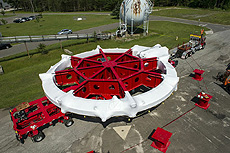 |
Brookhaven National Laboratory has set up the Muon g-2 ring on a truck, preparing it for this weekend's big move. Photo: Brookhaven National Laboratory |
The forecast for this weekend in Long Island predicts sunny and warm conditions, with highs around 80 degrees. As it turns out, that's perfect weather for moving a 50-foot-wide electromagnet wrapped in plastic.
After torrential rains delayed its original start date last week, the Muon g-2 collaboration is set to begin moving the giant electromagnet from New York to Illinois on Saturday. The device, built at Brookhaven National Laboratory, is the centerpiece of Fermilab's Muon g-2 experiment—or, it will be, once it completes its 3,200-mile land-and-sea journey to the Chicago suburbs.
That journey begins with a trek across the Brookhaven site to the main gate on Saturday morning and continues down the William Floyd Parkway to the Smith Point Marina on Sunday night and Monday morning, a trip that should take about six hours. The truck will move between 5 and 10 miles per hour, and crews will walk alongside it, ensuring that obstacles are removed.
Once at the marina, the ring will be loaded onto a barge and begin its journey to Illinois. You can get a "ringside" seat for that trip on the Muon g-2 website, where you'll find a GPS-powered map and regular updates from the move.
After four to six weeks of travel, the barge will port in Lemont, Ill., and the ring will then be loaded onto a truck and driven to Fermilab over three consecutive nights. Once here, it will be used to store and study muons, following up on a similar experiment conducted at Brookhaven in the 1990s. The goal is to discover whether the magnetic wobble of the muon agrees with the standard model prediction. If not, there could be new vistas of physics awaiting discovery.
—Andre Salles
|
Mysterious subatomic particle may represent exotic new form of matter
From Wired, June 17, 2013
In the course of exploring the properties of a strange subatomic particle, physicists may have stumbled upon something even stranger: a mysterious and exotic new form of matter.
The intriguing discovery was made more or less simultaneously by two collaborations: the Belle experiment at the Japanese High Energy Accelerator Research Organization (KEK) and BESIII experiment run by the Institute of High Energy Physics (IHEP) in China.
Read more |
|
Hunting for light dark matter in a bubble chamber
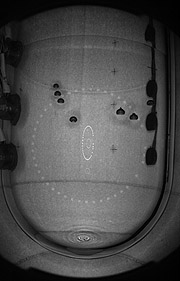 |
| The COUPP Collaboration uses bubble chambers to look for dark matter. This photo shows a seven-bubble event induced by a neutron calibration source in the COUPP-60 detector, now running underground at SNOLAB in Ontario, Canada. Photo: COUPP |
The headline story in the April 15 issue of Fermilab Today featured the observation by the CDMS experiment of three candidate events that could have been produced by dark matter. That result, combined with several other possible signals, points to a dark matter candidate that is much lighter than expected. While no one is claiming that dark matter has definitely been discovered, there is certainly a lot of interest in this low-mass region of space.
The COUPP collaboration builds bubble chambers to look for dark matter. A bubble chamber consists of a superheated fluid, or a fluid that is heated past its boiling point (like this mug of water), and when a particle interacts in the liquid, enough heat can be deposited to form a bubble. The key for COUPP bubble chambers is that, to form a bubble, the particle must deposit its energy over a relatively small distance. One of the biggest backgrounds to dark matter searches comes from gamma rays. Because gamma rays deposit their energy over a distance that is large compared to the bubble, they don't produce events in the COUPP bubble chamber. Therefore, COUPP never even sees the largest background to dark matter searches. That's a good thing when you're looking for tiny signals that would otherwise be awash in unwanted backgrounds.
What does this have to do with the CDMS result and light dark matter? Well, historically, COUPP has used a chemical called CF3I as the target in its bubble chambers (including the new COUPP-60 experiment, which is just beginning its physics run this week). However, CF3I is not ideally suited to looking for light dark matter because it's too heavy.
Containing just carbon and fluorine, C3F8 is an ideal target to look for light dark matter. Recently, COUPP used C3F8 inside a bubble chamber to see whether it has the same level of rejection against the gamma rays, and the preliminary data show that a C3F8 target does just fine. The plot below shows that gamma rejection: At a 3-keV threshold, the probability of a gamma ray making a bubble is less than 1 in 100 million. At that threshold, if the CDMS signal were real, a 2-liter C3F8 chamber would expect to see almost 1 event per day coming from dark matter. With this result in hand, COUPP is now trying to deploy a small chamber with C3F8 to start hunting dark matter this summer. If all goes well, the mystery of light dark matter may be solved a year from now.
—Hugh Lippincott
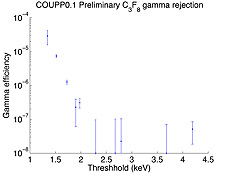 |
| At a 3-keV threshold, the probability of a gamma ray making a bubble is less than 1 in 100 million. At that threshold, if the CDMS signal were real, a 2-liter C3F8 chamber would expect to see almost 1 event per day coming from dark matter. |
|
DASTOW takes place today
Fermilab's Daughters and Sons to Work (DASTOW) day takes place during the first half of today. Families can enjoy the Mr. Freeze cryogenics show, a Fermilab Fire Department demonstration of firefighting skills and safety and lunch in the Wilson Hall atrium. For a full schedule of events, visit the DASTOW Web page.
This year's DASTOW includes the first Fermilab Children's Art Exhibit, sponsored by NALWO, in Wilson Hall atrium. The artwork, which includes drawings, paintings and three-dimensional models, will be on display for a half-day only, from 8:30 a.m. to 12:30 p.m.
|
Neutrinos: nature's ghosts?
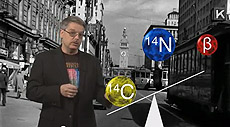 |
Neutrinos are ghosts of the microworld, almost not interacting at all. In this video, US CMS Education and Outreach Coordinator Don Lincoln describes some of their properties and how they were discovered. Studies of neutrinos are expected to be performed at many laboratories across the world and to form one of the cornerstones of the Fermilab research program for the next decade or more. View the video. Video: Fermilab |
|
Owl in broad daylight
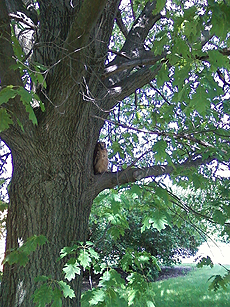 |
An owl reacts to having its picture taken by putting its back up against the tree. Photo: Jean Wilson, PPD |
|
|